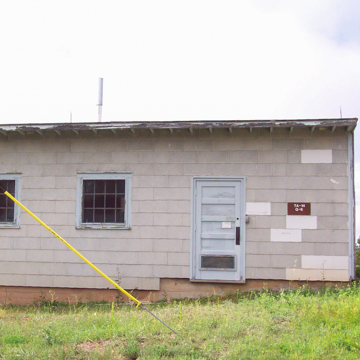You are here
Q-Site
Q-Site in Technical Area 14 was used to record small-scale cylinder implosions with a rotating prism camera and flash photography. Set up in 1944, the site originally included high explosives magazines, a control building, firing chambers, and the surviving shop and darkroom building (TA-14-6). Sheathed with tar paper and asbestos shingles, this simple structure has a shed roof and wood framing on a concrete slab foundation. The shop occupied three-quarters of the building, with the darkroom at the back, and had onsite water and septic tanks.
The building is eligible but not yet included in the Manhattan National Historical Park.
References
Los Alamos National Laboratory. The History and Legacy of the Manhattan Project at Los Alamos National Laboratory. Los Alamos, NM: Los Alamos National Laboratory, 2015.
McGehee, Ellen, Sheila McCarthy, Ken Towery, John Ronquillo, Kari Garcia, and John Isaacson. Sentinels of the Atomic Dawn: A Multiple-Property Evaluation of the Remaining Manhattan Project Properties at Los Alamos (1942–1946). Historic Building Survey Report No. 215. Los Alamos: Los Alamos National Laboratory, 2003.
National Park Service. Manhattan Project Sites. Special Resource Study/Environmental Assessment. Washington, D.C.: Department of the Interior, 2010.
Writing Credits
If SAH Archipedia has been useful to you, please consider supporting it.
SAH Archipedia tells the story of the United States through its buildings, landscapes, and cities. This freely available resource empowers the public with authoritative knowledge that deepens their understanding and appreciation of the built environment. But the Society of Architectural Historians, which created SAH Archipedia with University of Virginia Press, needs your support to maintain the high-caliber research, writing, photography, cartography, editing, design, and programming that make SAH Archipedia a trusted online resource available to all who value the history of place, heritage tourism, and learning.

